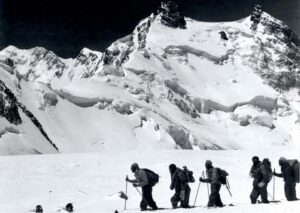How did ancient nomads reach North America?
Scientists have long believed that the continent’s first human visitors arrived about 13,000 years ago, during a brief period of icy connection between Asia and North America.
But new research from PNAS suggests a different story. They walked across a sturdy “sea ice highway” — perhaps reaching North America many thousands of years earlier than once thought.
A needle in an underwater haystack
It is difficult to make accurate predictions about how and when humans crossed Beringia, a landmass that once connected Asia to North America. That’s because the human evidence is likely down in Davy Jones’ locker, said Jesse Farmer, a paleoceanographer at the University of Massachusetts Boston.
View this post on Instagram
“If finding a suitable archaeological site on land is like finding a needle in a haystack, in Beringia it’s like finding a needle in a haystack that is buried under 150ft [45m] of ocean water,” Farmer told LiveScience.
Now, a growing body of evidence suggests that humans arrived between 14,000 to 24,000 years ago, according to a study presented Dec. 15 at the American Geophysical Union Annual Meeting.
Given that glacial currents were much stronger back then, travel by paddleboat was likely not a viable option. Instead, the nomads simply arrived much earlier, when sea ice was plentiful, according to a statement from the American Geophysical Union.

Currents were much stronger in the ancient past, which would make travel by paddleboat difficult, scientists said. Photo: Grid-Arendel/Flickr
Reconsidering the migration timeline
For the latest study, led by Summer Praetorius of the U.S. Geological Survey, the team focused on reconstructing ancient ocean currents of the Pacific Northwest.
Praetorius and her team analyzed climate proxies from ocean sediment along the coast, primarily using fossilized plankton. By examining the abundance and chemistry of these fossils, they reconstructed past ocean temperatures, salinity levels, and sea ice cover.
Their research found that during the last glacial maximum about 20,000 years ago, ocean currents were more than twice as strong as they are today. The causes? Stronger glacial winds and lower sea levels.
Navigating these strong currents by boat would have been challenging. Moreover, the study concluded that a significant portion of the coastal region remained covered by winter sea ice until 15,000 years ago.
This finding has led to the hypothesis that early Americans might have used this “ice highway” as a means of travel. Much like the modern Arctic peoples, who use sea ice for transportation, ancient humans could have moved across the ice, hunting marine mammals along the way.
Praetorius said that the “sea ice highway” theory does not preclude other migration routes or methods. The Alaskan current had calmed down by 14,000 years ago, making it easier for people to travel by boat along the coast.
“Nothing is off the table,” she said. “We will always be surprised by ancient human ingenuity.”






